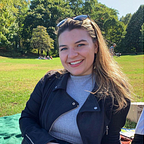The relationship between us and music
Our relationship with music changes in the way that our relationships with others change. Not that long ago, we used to walk around with Walkmans, physically rewinding the tape to listen. Now, we walk with our ears in our headphones and phones sitting in our pockets playing the soundtrack to our daily lives. Instead of burning CDs, we make playlists share our musical tastes, and instead of switching out CDs in our cars, we plug in our phones. Our relationship with music grows and evolves as we do.
Now we’re surrounded by the immediacy of songs, with hundreds of thousands of them available at our fingertips. Spending more time at home last year, I listened to almost 100,000 minutes of songs. That’s a lot of feelings. So it goes with technology to connect us to our friends. Ultimately, the choice is ours. The autonomy and digitization of music carry over to our relationships. Shaped and defined by music, our relationships mold how songs we can relate them to and which playlists we play to feel certain feelings. We are given so many choices and so many possibilities to choose from that sometimes the choice can be overwhelming.
And yet, we still make mixtapes for our loved ones, sometimes taking shape as Spotify playlists. We share music like to share our love for one another. We want to let someone into our musical worlds. We want them to experience the same feelings that we felt, listening to the songs that remind us of them. It seems that my friends and I almost every day send each other songs that remind us of each other, playlists to help us get through work, or start our day with a brisk walk. This becomes another form of letting someone into our little worlds, sharing our feelings through sharing the songs that make us feel.
These feelings aren’t limited to feelings of love and lust, however. Music and love have been as intertwined as music and heartbreak. John Cusack holding a boombox above his head blasting Peter Gabriel’s “In Your Eyes” is as prevalent as Beyonce’s direction for her ex-man’s stuff — to the left, to the left. We turn to breakup playlists like we turn to our best friends. We drown ourselves in the soundwaves of other people’s hurt, finding solace in the fact that we’re not alone in feeling the way we feel, whether it be through Phoebe Bridgers’ lyrics or Billy Joel’s. I remember running around the playground in the fifth grade, belting the lyrics to Aly & AJ’s “Potential Breakup Song.” Of course, I hadn’t been in a relationship at the time, but now years later, I found myself circling back to the emotions found in that song. Now, I listen to the newly released version with excitement and remembrance of youth.
Music and emotions are always intrinsically linked. Fear strikes those who hear the first dun-nun in “Jaws” and John Williams’ “Imperial March,” which signifies Darth Vader's arrival. It can make us feel emotions long dormant or remind us of a time with someone we care about. Many people I know have sad playlists designed to make the listener cry after a few songs are played on shuffle — I am even one of those people. Playlists can have a common theme of emotion that the listener is subjected to when making their way through the varying songs.
I think about the importance of choice and how sometimes illumination allows us to determine better what we enjoy and what we don’t. This same principle applies to music. I never thought that I would enjoy country music until I sat down and listened to it. I thought I knew that I didn’t like the Nordic heavy metal that my oldest brother listens to until I heard him blasting it from his room. We get the chance to grow our musical library by constantly expanding what we like and exploring different genres and artists. We find what we like, and then we constantly want more of that.
Growing up, music played a significant role in my life. My dad took my brothers to classic rock concerts, who shared a common love for Rush, Def Leppard, and the like. I burned CDs for both myself and my friends as another way of sharing music and letting others into my world. When my best friend and I drove down the winding streets of Long Island, her car driving into the late hours, we always either started or ended with Frank Sinatra’s collection of classics, “Nothing But the Best.” With baritone voices and a hyper-enthusiasm for singing about the good old days, we tackled his songs like we tackled that night’s issues — talking about our torn heartbreaks and familial expectations. When I think about my teenage years, I think about playing Green Day, Paramore, and other bands to demonstrate rebellion against my parents.
As we grow and we learn, we start inadvertently becoming what we’re learning from. Little pieces of me have been left in the playlists that I’ve made, either appearing in forms of ones that I’ve made for myself or others. Each song has a personal connection — a place where I first heard the song, much like the people that come and go in my life.
